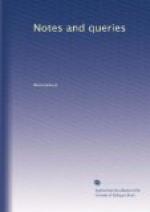Hickford’s Rooms, Panton Street, Haymarket.—These rooms, under the name of “Hickford’s Dancing Rooms,” were in existence as early as 1710. In 1738, they were opened as the “Musick-room.” A contemporary account says:—
“The band was selected from the Opera House; but the singularity most attractive consisted of an organ combined with a harpsichord, played by clock-work, which exhibited the movements of an orrery and air-pump, besides solving astronomical and geographical problems on two globes, and showing the moon’s age, with the Copernican system in motion.”
In 1740, Mr. Galliard’s benefit is announced to take place “at Mr. Hickford’s Great Room in Brewer Street, Golden Square.”—See the Daily Post of March 31. The “Great Room” is now known as “Willis’s Dancing Academy.”
The Music Room in Dean Street, Soho.—The Oratorio of Judas Maccabeus was performed here in great splendour in 1760. It was afterwards the auction room of the elder Christie; and is now “Caldwell’s Dancing Academy.” George III. frequently honoured this “musick-room” with his presence.
The Music Room in Charles Street, Covent Garden:—
“The Consort of Musick,
lately in Bow Street, is removed next
Bedford Gate, in Charles
Street, Covent Garden, where a room
is newly built for that purpose.”—Lond.
Gaz. Feb. 19. 1690.
“A Consort of Music,
with several new voices, to be performed on
the 10th instant, at the Vendu
in Charles Street, Covent
Garden.”—Ibid.
March 6. 1691.
In 1693 was published Thesaurus Musicus, being a Collection of the “Newest Songs performed at their Majesties’ Theatres, and at the Consorts in Villier Street, in York Buildings, and in Charles Street, Covent Garden.”
In the proposals for the establishment of a Royal Academy in 1720, the subscription books are advertised as being open, amongst other places, “at the Musick Room in Charles Street, Covent Garden.”
Coleman’s Music House.—A house of entertainment, with a large and well planted garden, known as “Coleman’s Musick House,” was offered for sale in 1682. It was situated near Lamb’s Conduit, and was demolished upon the building of Ormond Street.
White Conduit House.—The old tavern of this name was erected in the reign of Charles I. The workmen are said to have been regaling themselves upon the completion of the building, at the instant the king was beheaded at Whitehall. {396}
Goodman’s Field Wells.—A place of entertainment established after the suppression of the theatre in this locality in 1735.
Bride Lane, St. Bride’s.—The first meetings of the Madrigal Society (established in 1741) were held at a public-house in this lane, called “The Twelve Bells.”
EDWARD F. RIMBAULT.
* * * * *




